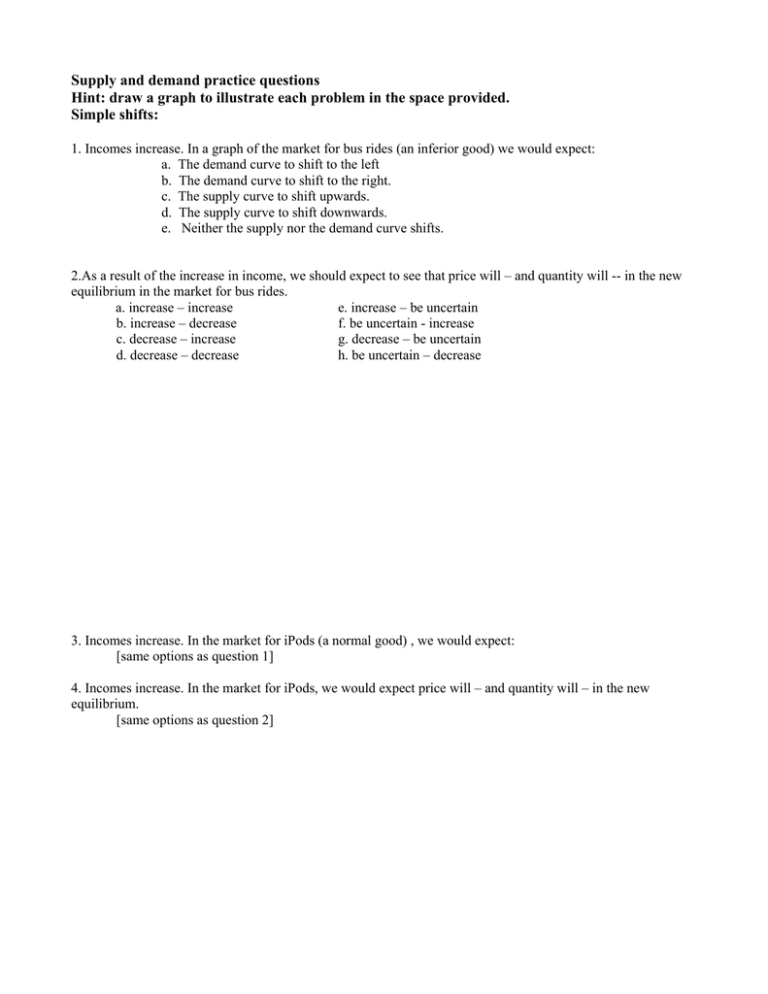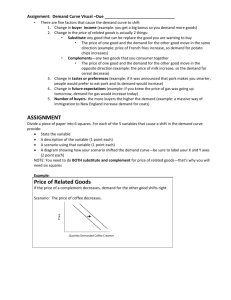Supply and demand practice questions Hint: draw a graph to
advertisement

Supply and demand practice questions Hint: draw a graph to illustrate each problem in the space provided. Simple shifts: 1. Incomes increase. In a graph of the market for bus rides (an inferior good) we would expect: a. The demand curve to shift to the left b. The demand curve to shift to the right. c. The supply curve to shift upwards. d. The supply curve to shift downwards. e. Neither the supply nor the demand curve shifts. 2.As a result of the increase in income, we should expect to see that price will – and quantity will -- in the new equilibrium in the market for bus rides. a. increase – increase e. increase – be uncertain b. increase – decrease f. be uncertain - increase c. decrease – increase g. decrease – be uncertain d. decrease – decrease h. be uncertain – decrease 3. Incomes increase. In the market for iPods (a normal good) , we would expect: [same options as question 1] 4. Incomes increase. In the market for iPods, we would expect price will – and quantity will – in the new equilibrium. [same options as question 2] Simple shifts (continued) 5. The price of computer memory chips increases. In the market for computers, we would expect to see: a. The demand curve to shift to the left b. The demand curve to shift to the right. c. The supply curve to shift upwards. d. The supply curve to shift downwards. e. Neither the supply nor the demand curve shifts. 6. The price of computer memory chips increases. In the market for computers, we would expect price will – and quantity will – in the new equilibrium. a. increase – increase e. increase – be uncertain b. increase – decrease f. be uncertain - increase c. decrease – increase g. decrease – be uncertain d. decrease – decrease h. be uncertain – decrease 7. New techniques in the production of LCD screens make it possible to produce them at lower marginal cost. In the market for televisions using LCD screens, we would expect to see: [same options as question 5] 8. New techniques in the production of LCD screens make it possible to produce them at lower marginal cost. In the new equilibrium in the market for televisions using LCD screens, price will – and quantity will --. [same options as question 6] Double shifts (again, draw graphs to help your intuition) 1. Wages of bus drivers increase. At the same time, incomes of consumers generally increase. In the market for bus rides, we should expect to see curves shift. The supply curve will --- and the demand curve will ---. a. shift up – shift to the left e. shift up – remain unchanged b. shift up – shift to the right f. shift down – remain unchanged c. shift down – shift to the left g. remain unchanged – shift left d. shift down – shift to the right h. remain unchanged – shift right 2. As a result of the simultaneous increase in the wages of bus drivers and of consumer incomes, we would expect that price will -- and the quantity of bus rides will --- in the new equilibrium. a. increase – increase e. increase – be uncertain b. increase – decrease f. decrease – be uncertain c. decrease – increase g. be uncertain -- increase d. decrease – decrease h. be uncertain – decrease. 3. The price of gasoline falls and consumer incomes generally increase. In the market for bus rides, we should expect to see a curve or curves shift. The supply curve will – and the demand curve will --. [same options as question 1] 4. As a result of the simultaneous fall in gasoline prices and the rise in consumer incomes, we should expect to see in the new equilibrium that price will – and the quantity of bus rides will --. [same options as question 2] Double shifts (continued) 5. The price of tea increases. At the same time, robots are developed which prove to lower the cost of production of coffee . In the market for coffee, we should expect to see curves shift. The supply curve will --- and the demand curve will ---. a. shift up – shift to the left e. shift up – remain unchanged b. shift up – shift to the right f. shift down – remain unchanged c. shift down – shift to the left g. remain unchanged – shift left d. shift down – shift to the right h. remain unchanged – shift right 6. As a result of the simultaneous increase in the price of tea and of the drop in the cost of production of coffee, we would expect that price of coffee will -- and the quantity of coffee will --- in the new equilibrium. a. increase – increase e. increase – be uncertain b. increase – decrease f. decrease – be uncertain c. decrease – increase g. be uncertain -- increase d. decrease – decrease h. be uncertain – decrease. 7. Wages of workers who pick coffee rise. At the same time, the price of half-and-half (a complement for coffee) decreases. In the market for coffee, we should expect to see curves shift. The supply curve will --- and the demand curve will ---. [same options as question 5] 8. As a result of the simultaneous rise in the wages of coffee workers and fall in the price of half-and-half, we would expect that price of coffee will -- and the quantity of coffee will --- in the new equilibrium. [same options as question 6] Answers to supply and demand multiple choice questions: Simple shifts: Quest ions 1-2 (income increase). Since we are looking at an inferior good (bus rides), the quantity demanded will decline at any given price (Richer consumers will buy a car and not ride the bus as often). Graphically, the demand curve shifts to the left (option a in question 1) and we expect the price and quantity to both drop (option d in question 2). Questions 3-4. Incomes increase and we are looking at a normal good. Richer consumers throw away their old Walkman and buy an iPod. At any given price, the quantity of iPods demanded will increase. Graphically, the demand curve shifts to the right (option b in question 3) and we expect price and quantity to both increase (option a in question 4). Questions 5-6. Increased price of computer memory chips raises the cost of production of computers. The supply curve shifts up (option c), indicating that computer producers want to pass the price increase on to consumers. We expect price to increase but quantity to decrease. (option b). Note: -- a movement upward on the graph is a decrease in supply. -- when a supply curve shifts, price and quantity move in opposite directions. Questions 7-8. Lower marginal cost means producers are willing to accept lower prices for the television sets. The supply curve for televisions shifts down (an increase in supply), and we expect price to decrease and quantity to increase. Options D and C are correct. Double shifts: Questions 1-2. The wage increase for bus drivers increases the cost of production, and the supply curve will shift up and to the left (a decrease in supply). Higher incomes reduce the demand for bus rides. Option A of qu. 1 describes the curve shifts; both changes tend to reduce quantity, but pull in opposite directions on the price. Option H of question 2 indicates that price is uncertain and quantity definitely decreases. Questions 3-4. Falling gas prices reduce the cost of production of bus rides and shift supply down and to the right. Consumer incomes rise, reducing the demand for bus rides. Option C of question 3 describes the shifts. Price definitely falls; quantity change is uncertain. Option F of question 4 is the appropriate one. Questions 5-6. When the price of tea (a substitute for coffee) increases, the demand for coffee will increase as some tea drinkers switch to coffee. The demand curve shifts rightwards. At the same time, robotic coffee pickers lower the cost of production of coffee, so the supply curve shifts down and to the right. Option D describes the curves shifting. Both changes tend to increase the quantity of coffee; however the increase in demand tends to pull price up, and the robots tend to pull price down. We are uncertain whether price will be higher or lower in the new equilibrium, but we know quantity will be higher. Option G is correct for question 6. Questions 7-8. Higher wages for coffee pickers increase the cost of production, so supply shifts up and to the left on the graph. A fall in the price of a complement for coffee will lead some to demand more coffee at the same coffee price. Option B of question 7 describes the shifts; the result is a definitely higher price (producers want it as a result of higher input prices; consumers are willing to pay it as a result of the fall in half-and-half prices) but an uncertain quantity (producers want to reduce the quantity supplied at any given price; consumers want more at any given price). Option E is appropriate for question 8.








